Jan 12, 2008 | gold, silver
An old Chinese proverb (or curse) says “May you live in interesting times.” When looking at the various conditions that make up the numismatic world, these times are certainly interesting.
The big news of the week, the price of gold hit the $900 per ounce level before backing off and closing at just under $895. Quietly, the price of silver has hit historical highs, closing at $16.23. Regardless of a coin’s numismatic value, the metal values drives up the price of coins. So if you had a roll of circulated Jefferson War Nickels, those coins contain $36.53 of silver and a total of $37.39 in its total melt value. Your old hoards may now be worth something!

While rising metal values are exciting as a story, I have written about what it could mean in other areas of investments and in the economy. For numismatics, that means all prices will go up at least proportional to the rise in the price of metals. Even those early gold coins that are considered “common” whose price is tied to the value of the metals will now see a rise in price. I wish I had started watching the pricing trends with Saint Gaudens Double Eagles as the market was rising. In addition to their numismatic value, the common price of lower grade coins are over $1,000.
As I write this, the Florida United Numismatics (FUN) Show is underway in Orlando, Florida. FUN is always the first show of the year. With the current state of the economy, the rising prices, and the weakening of the US dollar, it will be interesting to hear the stories from the bourse floor—the guys and gals in the trenches. I hope they report that it is still a good market!
Jan 4, 2008 | economy, gold
With the price of gold rising above $866, it has surpassed the record high of $850 set in January 1980. Some market watchers have show some irrational exuberance with predictions about where the price is going and what investors may consider. Few have picked up on the actual worth of gold by today’s standard is worth less than in 1980 and not as exciting as it is being made out to be.
Let me explain… money is a commodity that is traded openly on the markets. As a commodity, it is bought and sold by investors whose value is based on how the market perceives the strength of its buying power. When prices go up as the purchasing market demands more to meet its obligation, the value of the commodity goes down. Other factors include the amount of money in circulation and the return on the investments made with that money. This is why the dollar has taken a beating since the beginning of the mortgage crisis as the Federal Reserve Board of Governors adds liquidity (more money) to the market to stimulate growth.
The impact of inflation on money is the difference in its buying power. Thus, if you wanted to have the same buying power that $1 would buy in 1980, you would have to spend $2.55 today. In simple terms, you are paying 155-percent more for goods and services today than you were paying in 1980. When looking at the numbers, investors should consider the impact of inflation when purchasing a commodity like gold.
Since this is about gold, if we look at it in terms of buying power, if you bought gold at its record high price of $850 in 1980 and held it until today, the price of that gold adjusted for inflation is $2,168.09. Which means that if you sold that gold at today’s market price of $866, you would have made $16 in real dollars, but you would have lost $1,302 in your economic buying power.
As an interesting side note, under the current tax law you would have to pay capital gains tax on the $16 “profit.”
Commodities is a very difficult market to earn a good return on investment. Professionals get higher returns by trading shares, futures, and other financial instruments based on the commodity. Owning gold as a bullion investment is very risky. Numismatic gold may be different in that its price can also be tied to the numismatic value of the coin and not just the metal value. I am sure the owners of coins like 1907 and 1927-D Saint Gaudens Double Eagles would agree!
Before I wrap up this posting, the highest price for oil in 1980 was $38 per barrel. Adjusting for inflation, that would be equivalent to buying oil at around $96 per barrel. Interestingly, that is about the average for the cost of oil today. Economically, if we are using 1980 as the benchmark, we are not paying any more for a barrel of oil today than we did in 1980. Although other market factors impacts the economy differently today, think about the economic climate that may affect the 2008 elections and those that had an impact in 1980.
Calculations were made using the inflation calculator at the Bureau of Labor Statistics
Oct 18, 2007 | coins, gold, US Mint
Yesterday was a busy day in the coin industry. Aside from the announcements from the American Numismatic Association, the US Mint resumed selling bullion coins. The newly priced American Gold Buffalo and American Gold Eagle proof coins have had their prices adjusted and can now be ordered. Based on a comparison of the new price, the prices are up $75 per ounce. Gold closed at $767.80 on October 18.
Here are the new prices compared with the old:
| Coin(s) |
Old Price |
New Price |
| American Buffalo One Ounce 24 Kt. Gold Proof |
$825.95 |
$899.95 |
| American Eagle One-Ounce Gold Proof |
$789.95 |
SOLD OUT |
| American Eagle Half-Ounce Gold Proof |
$399.95 |
$459.95 |
| American Eagle Quarter-Ounce. Gold Proof |
$209.95 |
$239.95 |
| American Eagle Tenth-Ounce Gold Proof |
$104.95 |
$116.95 |
| American Eagle Four Coin Gold Proof Set |
$1,449.95 |
$1,649.95 |
It’s a good thing I received my 2007-W proof Buffalo over the summer, before the prices went up!
Oct 15, 2007 | coins, gold, platinum, US Mint
When I decided to take a week off, I did not think that there would be much news in the numismatic community. I knew that the US Mint would issue the 28-coin 2007 Mint Set with a satin finish. I figured that would be all of the news from the Mint until the release of the James Madison Dollar. But it seems that precious metals prices have had an effect on Mint products.
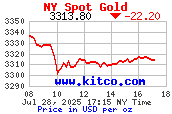 As the dollar weakens, investors are running to precious metals to protect their assets. This is driving up the prices for gold and platinum. The increased interested gold caused its spot price to reach $711.40 on September 12. Because the margin decreased, the Mint suspended sales of American Eagle gold coins on September 13.
As the dollar weakens, investors are running to precious metals to protect their assets. This is driving up the prices for gold and platinum. The increased interested gold caused its spot price to reach $711.40 on September 12. Because the margin decreased, the Mint suspended sales of American Eagle gold coins on September 13.
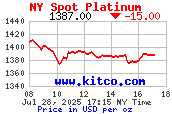 Platinum has also been surging. As of the market close on Friday, October 5, platinum closed at $1365—up over $300 this year— as gold closed at $741.30. When the markets opened on Monday, the Mint suspended sales of the platinum American Eagles and American Buffalo gold proof coins. The next day, bulk sales to dealers were halted. Only the silver and platinum proof American Eagles are still available.
Platinum has also been surging. As of the market close on Friday, October 5, platinum closed at $1365—up over $300 this year— as gold closed at $741.30. When the markets opened on Monday, the Mint suspended sales of the platinum American Eagles and American Buffalo gold proof coins. The next day, bulk sales to dealers were halted. Only the silver and platinum proof American Eagles are still available.
Dave Harper of Numismatic News speculates that the Mint acts when the threshold between the cost of the metals and the spot prices are within $100 of the Mint’s sales price. While he has no evidence of this, it is a plausible theory based on recent events as all bullion sales ceased when gold and platinum spot prices were within $100 of the Mint’s sales price.
Before the Mint can reprice these coins, they are required to publish the new prices in The Federal Register. Nothing has been announced. Market volatility may make this more difficult for the Mint than expected. It could take the Mint until the end of the month to set new prices to allow the market to settle.
Aug 16, 2007 | auction, gold, RCM
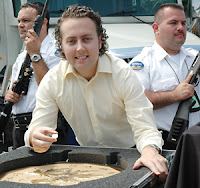 Have you ever wondered what a million dollars looks like? The picture to the right is Ian Russell, President of Teletrade, holding a one-ounce gold coin while leaning over the unique C$1 million coin. Yes, that large disk is a coin. In early May, the Royal Canadian Mint announced the production of a 100 kilogram (about 220 pounds, or 3,215 troy ounces) .99999 fine gold coin. With the price of gold as I type this currently at $666.60, its melt value is over $2.14 million!
Have you ever wondered what a million dollars looks like? The picture to the right is Ian Russell, President of Teletrade, holding a one-ounce gold coin while leaning over the unique C$1 million coin. Yes, that large disk is a coin. In early May, the Royal Canadian Mint announced the production of a 100 kilogram (about 220 pounds, or 3,215 troy ounces) .99999 fine gold coin. With the price of gold as I type this currently at $666.60, its melt value is over $2.14 million!
Teletrade, a division of Spectrum Numismatics International, is using the coin to advertise a new service for investors to purchase precious metal bullion coins. Not only it is the first coin of its type, but it is the most expensive coin offered in an Internet-only format. Teletrade displayed the coin being auctioned at the American Numismatic Association World’s Fair of Money recently held in Milwaukee.
As I type this, the current bid is $1.65 million. If you cannot find that much money between the cushions of your couch, you can get special financing from Collateral Finance Corporation, also a division of Spectrum. Happy bidding!
Image courtesy of Teletrade
Jul 18, 2007 | gold, history, quarter, rareties, US Mint
One of my favorite television shows is History Detectives, the PBS show where four people who have interests in various areas of antiques, history, and sociology research the background and history of artifacts people have found or had handed down to them by family members. Rather than determining the worth of an item like they do in Antiques Roadshow, the concentration is to learn about the item and its significance, or insignificance in history. Two of the History Detectives, Elyse Luray and Wes Cowen, have appeared on Antiques Roadshow.
Now in its fifth season, my local PBS television station showed the new second episode. One of the investigations was Dr. Gwendolyn Wright researching a Continental Currency $6 bill found by an Omaha, Nebraska family in a book. The story allows Dr. Wright to step outside of her area of architectural history to learn the historical significance of this note.
Rather than recap the segment here, you should visit the episode information on the History Detectives website to watch the eight minute video and read the transcript. I think you will find it as fascinating as I did.
When History Detectives are aired, the segments are concluded with another history detective giving more information about the general topic with more information. After the Continental Currency segment, Wes Cowen talked about the interesting history of US coins. Unfortunately, the two stories they used provided incorrect information.
The first mistake was saying that there was a public outcry from the public regarding the nudity on the Standing Liberty Type 1 Quarter. This myth was debunked by researcher Roger Burdette in his book Renaissance of American Coinage 1916-1921. Burdette writes that according to records from the US Mint and National Archives, designer Hermon A. MacNeil requested the change to make Lady Liberty look stronger in the face of the Great War (World War I).
The second mistake was the claim that the only legal 1933 Saint-Gaudens Double Eagle was smuggled out of the country. Although the coin was smuggled out of the Philadelphia mint, the State Department issued a legal export permit for a representative of King Farouk to carry the coin to Egypt. The State Department might have made a mistake, but that does not mean the coin was smuggled out of the country. To read more about this coin, I highly recommend the book Illegal Tender by David Tripp.
Even with these mistakes, I will continue to watch and recommend this show.
Jun 22, 2007 | coins, First Spouse, gold
When the Presidential $1 Coin Act of 2005 (Public Law 109-145 [GPO: Text/PDF]) was passed, I was concerned that the minting of the First Spouse 24-karat gold coins would not be a success. With the price of gold soaring over $600 per ounce for the last few years and the requirement to use domestic sources of gold, it was speculated that the coins would cost over $400 each. Eventually, the US Mint priced the proof coins at $429.95 and the uncirculated coins at $410.95. Would people buy the coins at these prices?
The Mint has never had a program like this making it difficult to make the comparisons against other US Mint products. There have been other gold coin programs and the American Eagles are produced in gold, but the First Spouse coins are the first 24-karat fractional gold series. It would even be difficult to compare these coins with the various commemorative coin programs that have not been successful. Thus, the Mint is charting new territory.
With a production limit of 40,000 for both proof and uncirculated coins, the Mint has sold out of the Martha Washington and Abigail Adams First Spouse Gold Coins after two days of being available. It is difficult to tell whether this is the result of first issue sales or there is a genuine interest in these coins. Only time will tell.
May 12, 2007 | CCAC, coins, commemorative, gold, US Mint
It was a busy week for me and the US Mint. While I was toiling to help another government agency from failing on one job, the Mint was demonstrating why it is the world’s largest manufacturer of numismatic items. So let’s look at the news…
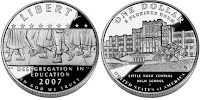 On May 4, the Mint announced that it will begin to take orders for the Little Rock Central High School Desegregation 50th Anniversary Silver Dollars on May 15, starting at noon. This coin commemorates the historical significance of the desegregation of Little Rock Central High School following the landmark 1954 Brown v. Board of Education decision by the US Supreme Court. For more about this coin, read my article “Little Rock Central High Commem Design.”
On May 4, the Mint announced that it will begin to take orders for the Little Rock Central High School Desegregation 50th Anniversary Silver Dollars on May 15, starting at noon. This coin commemorates the historical significance of the desegregation of Little Rock Central High School following the landmark 1954 Brown v. Board of Education decision by the US Supreme Court. For more about this coin, read my article “Little Rock Central High Commem Design.”
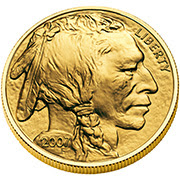 The Mint quietly dropped the discussion of producing fractional American Buffalo 24-karat Gold Coins and extended the potential release date until June. It is suspected that the Mint may require congress to pass necessary legislation in order to authorize the production fractional Buffalo coins, although this has not been confirmed by the Mint. Uncirculated 2007 Buffalo coins can be purchased from dealers and on the secondary market.
The Mint quietly dropped the discussion of producing fractional American Buffalo 24-karat Gold Coins and extended the potential release date until June. It is suspected that the Mint may require congress to pass necessary legislation in order to authorize the production fractional Buffalo coins, although this has not been confirmed by the Mint. Uncirculated 2007 Buffalo coins can be purchased from dealers and on the secondary market.
 Earlier this month, the Mint advertised that they would sell the First Spouse gold coins by the set at $1,675.95. But the Mint announced this week that they will begin to sell First Spouse gold coins individually started at noon on June 19, 2007 for the Martha Washington and Abigail Adams coins. Jefferson’s Liberty coin will be for sale on August 16 and the Dolley Madison coin on November 15. No set will be offered. Individual coins will sell for $429.95 as proof coins and $410.95 as uncirculated coins.
Earlier this month, the Mint advertised that they would sell the First Spouse gold coins by the set at $1,675.95. But the Mint announced this week that they will begin to sell First Spouse gold coins individually started at noon on June 19, 2007 for the Martha Washington and Abigail Adams coins. Jefferson’s Liberty coin will be for sale on August 16 and the Dolley Madison coin on November 15. No set will be offered. Individual coins will sell for $429.95 as proof coins and $410.95 as uncirculated coins.
The Mint also announced that the Citizens Coinage Advisory Committee (CCAC) will meet Tuesday, May 15, at the Philadelphia Downtown Marriott Hotel at 9 A.M. On the agenda is the design of the Congressional Gold Medal to honor the Dalai Lama as well as the proposed design for the 2008 American Bald Eagle Commemorative Coins.
Time to go take some pictures so I have some fun stuff to talk about.
All images from the US Mint.
May 4, 2007 | gold, RCM, US Mint
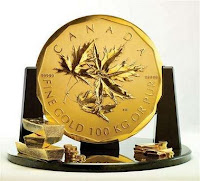 The Royal Canadian Mint announced they will be issuing a very large gold coin with a C$1 million denomination. At 100 kilograms (3215 troy ounces) and 53 centimeters (21 inches) it is the largest legal tender coin in existence. It will be made of .99999 pure gold making this coin the purest gold coin on the market. The obverse of the coin will feature Queen Elizabeth II with the reverse will feature a “new, elegant maple leaf design.”
The Royal Canadian Mint announced they will be issuing a very large gold coin with a C$1 million denomination. At 100 kilograms (3215 troy ounces) and 53 centimeters (21 inches) it is the largest legal tender coin in existence. It will be made of .99999 pure gold making this coin the purest gold coin on the market. The obverse of the coin will feature Queen Elizabeth II with the reverse will feature a “new, elegant maple leaf design.”
As part of this project, RCM announced they will be producing a more affordable one troy ounce coin that will be 30 mm and made from .99999 pure gold. This coin will have a face value of C$200. RCM has not released the final pricing for these coins.
It is an ambitious project for RCM. Gold this pure can be difficult to strike because of the softness of the metals. Pricing will be an interesting issue. At today’s 4:00 PM New York gold price of $686.90, the 3215 troy ounce coin contains $2,228,990.50 in the value of the metal. I am guessing that RCM may charge $3 million for this coin.
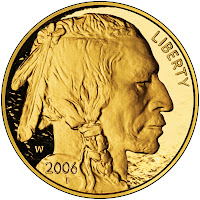 RCM could price the new one troy ounce coin more competitively with the market. Their nearest competitor will be the US Mint’s American Gold Buffalo, which is one avoirdupois (regular) ounce of .9999 pure gold making the RCM coin lighter than the Gold Buffalo (1 troy ounce = 1.0971 ounces). RCM may price their coin competitively with the Gold Buffalo—which the US Mint announced will it will charge $850 for a 2007 proof coin. Bullion sales appear to average $75-100 over the spot price of gold.
RCM could price the new one troy ounce coin more competitively with the market. Their nearest competitor will be the US Mint’s American Gold Buffalo, which is one avoirdupois (regular) ounce of .9999 pure gold making the RCM coin lighter than the Gold Buffalo (1 troy ounce = 1.0971 ounces). RCM may price their coin competitively with the Gold Buffalo—which the US Mint announced will it will charge $850 for a 2007 proof coin. Bullion sales appear to average $75-100 over the spot price of gold.
It is an interesting publicity gimmick for the RCM. I would be surprised if they sold more than a dozen of the C$1 million coins.
Canadian coin image from the Royal Canadian Mint
American Gold Buffalo image from the US Mint
Apr 25, 2007 | Eagles, gold, US Mint
Building on the success of last year’s program, the US Mint announced that the uncirculated 2007-W American Eagle Gold coins will go on sale April 27, 2007. These uncirculated coins minted in West Point for collectors will be struck on specially burnished planchets to give them a satin-like finish. Each coin will be encapsulated in a plastic capsule and come with a Certificate of Authenticity from the US Mint.
These coins can be ordered from the Mint via the phone (800-USA-MINT) or from their online catalog in one-ounce ($749.95), half-ounce ($379.95), quarter-ounce ($195.95), and tenth-ounce ($89.95) varieties. Also available is the American Eagle Gold Uncirculated Four-Coin Set for $1,379.95. The prices represent more than a 4-percent increase over last year to account for the rising cost of gold. The Mint charges $4.95 for standard shipping.









